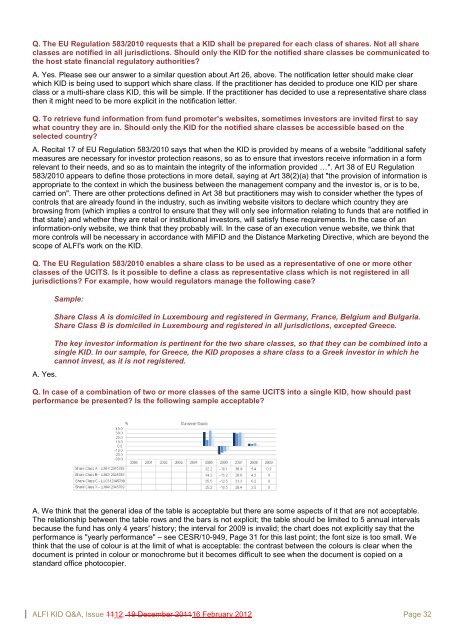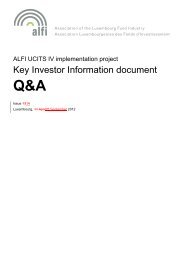Q&A - Alfi
Q&A - Alfi
Q&A - Alfi
You also want an ePaper? Increase the reach of your titles
YUMPU automatically turns print PDFs into web optimized ePapers that Google loves.
Q. The EU Regulation 583/2010 requests that a KID shall be prepared for each class of shares. Not all share<br />
classes are notified in all jurisdictions. Should only the KID for the notified share classes be communicated to<br />
the host state financial regulatory authorities?<br />
A. Yes. Please see our answer to a similar question about Art 26, above. The notification letter should make clear<br />
which KID is being used to support which share class. If the practitioner has decided to produce one KID per share<br />
class or a multi-share class KID, this will be simple. If the practitioner has decided to use a representative share class<br />
then it might need to be more explicit in the notification letter.<br />
Q. To retrieve fund information from fund promoter's websites, sometimes investors are invited first to say<br />
what country they are in. Should only the KID for the notified share classes be accessible based on the<br />
selected country?<br />
A. Recital 17 of EU Regulation 583/2010 says that when the KID is provided by means of a website "additional safety<br />
measures are necessary for investor protection reasons, so as to ensure that investors receive information in a form<br />
relevant to their needs, and so as to maintain the integrity of the information provided …". Art 38 of EU Regulation<br />
583/2010 appears to define those protections in more detail, saying at Art 38(2)(a) that "the provision of information is<br />
appropriate to the context in which the business between the management company and the investor is, or is to be,<br />
carried on". There are other protections defined in Art 38 but practitioners may wish to consider whether the types of<br />
controls that are already found in the industry, such as inviting website visitors to declare which country they are<br />
browsing from (which implies a control to ensure that they will only see information relating to funds that are notified in<br />
that state) and whether they are retail or institutional investors, will satisfy these requirements. In the case of an<br />
information-only website, we think that they probably will. In the case of an execution venue website, we think that<br />
more controls will be necessary in accordance with MiFID and the Distance Marketing Directive, which are beyond the<br />
scope of ALFI's work on the KID.<br />
Q. The EU Regulation 583/2010 enables a share class to be used as a representative of one or more other<br />
classes of the UCITS. Is it possible to define a class as representative class which is not registered in all<br />
jurisdictions? For example, how would regulators manage the following case?<br />
A. Yes.<br />
Sample:<br />
Share Class A is domiciled in Luxembourg and registered in Germany, France, Belgium and Bulgaria.<br />
Share Class B is domiciled in Luxembourg and registered in all jurisdictions, excepted Greece.<br />
The key investor information is pertinent for the two share classes, so that they can be combined into a<br />
single KID. In our sample, for Greece, the KID proposes a share class to a Greek investor in which he<br />
cannot invest, as it is not registered.<br />
Q. In case of a combination of two or more classes of the same UCITS into a single KID, how should past<br />
performance be presented? Is the following sample acceptable?<br />
A. We think that the general idea of the table is acceptable but there are some aspects of it that are not acceptable.<br />
The relationship between the table rows and the bars is not explicit; the table should be limited to 5 annual intervals<br />
because the fund has only 4 years' history; the interval for 2009 is invalid; the chart does not explicitly say that the<br />
performance is "yearly performance" – see CESR/10-949, Page 31 for this last point; the font size is too small. We<br />
think that the use of colour is at the limit of what is acceptable: the contrast between the colours is clear when the<br />
document is printed in colour or monochrome but it becomes difficult to see when the document is copied on a<br />
standard office photocopier.<br />
ALFI KID Q&A, Issue 1112, 19 December 201116 February 2012 Page 32

















